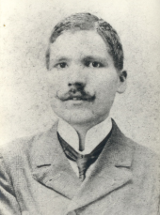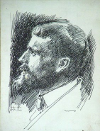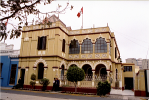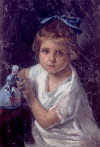U.Porto Memory
University of Porto Famous Alumni
Raul Maria Pereira
 |
Raul Maria Pereira 1877-1933 Painter, architect and diplomat |
 Raul Maria Pereira, son of Joaquim Maria Pereira and Filomena de Jesus Alves, was born on 18 June 1877 to a family of Douro farmers in Donelo, in the village of Covas do Douro, council of Sabrosa.
Raul Maria Pereira, son of Joaquim Maria Pereira and Filomena de Jesus Alves, was born on 18 June 1877 to a family of Douro farmers in Donelo, in the village of Covas do Douro, council of Sabrosa.
He lost his mother at a very young age and his father left for Porto looking for work. Later, along with his two brothers he joined his father after the latter remarried. His step mother recognized his artistic skills and went against the will of his father, who wanted him to follow the religious life, so he enrolled at the Porto Academy of Fine Arts in 1890.
 Here he attended courses in Historical Drawing, Sculpture, Artistic Anatomy, Civil Architecture and Historical Painting. He was taught by Marques de Oliveira who became his friend, and was a class colleague of Paulino Gonçalves and Acácio Lino.
Here he attended courses in Historical Drawing, Sculpture, Artistic Anatomy, Civil Architecture and Historical Painting. He was taught by Marques de Oliveira who became his friend, and was a class colleague of Paulino Gonçalves and Acácio Lino.
In Porto, he attended the workshop of the painter from Trás-os-Montes, João Augusto Ribeiro, who was decisive for his training because, in addition to teaching him painting, he awakened in him an interest in Literature, History and Philosophy.
As a student, he visited Salamanca, attracted by the colour of the city and some of its facilities, such as Casa das Conchas, the Monterey Palace and Praça dos Colégios Menores, and Madrid, where he sought inspiration in the paintings of the great masters exhibited in the Prado Museum. To help with his study expenses, he retouched and enlarged photos in the photo studio of Raul de Caldevilla - Fotografia União – and made crayon portraits. He was suspended for one year for claiming a wash basin and a towel in the classroom, a claim denied by the Board of the Porto Academy.
 In 1901 he completed the 5th year of Historical Painting with the final mark of 16 out of 20. In the following year he competed with Acácio Lino and Manuel José Teixeira da Silva, from the school of Porto, and Constantino Álvaro Sobral Fernandes, from the school of Lisbon, for a State grant to study Historical painting abroad. Although he lost to Constantino Fernandes, he received a scholarship in Rome in 1903, for four years, sponsored by the Viscount of S. João da Pesqueira, who was delighted with the oil portrait of the Count of Paço Vieira painted by the artist. Raul had met the Count while working at Fotografia União.
In 1901 he completed the 5th year of Historical Painting with the final mark of 16 out of 20. In the following year he competed with Acácio Lino and Manuel José Teixeira da Silva, from the school of Porto, and Constantino Álvaro Sobral Fernandes, from the school of Lisbon, for a State grant to study Historical painting abroad. Although he lost to Constantino Fernandes, he received a scholarship in Rome in 1903, for four years, sponsored by the Viscount of S. João da Pesqueira, who was delighted with the oil portrait of the Count of Paço Vieira painted by the artist. Raul had met the Count while working at Fotografia União.
While abroad, he set up a workshop in Rome and travelled to the artistic centres in Italy and Greece, visiting cities such as Vienna, Budapest, Istanbul, Munich, Paris and Madrid. During this phase of his life, he studied pictorial representation of the human figure and of landscape at the Academy of Rome. He painted portraits and landscapes, painted copies of Ticiano, Van Dyck and Velásquez, and participated in the Grand Salon of Rome in 1907. He showcased three paintings at this art exhibition, including "Donna Veneziani", which was bought by the Italian government. In 1907 he was hired by D. Pedro Travesari, director of the School of Fine Arts of Quito, who had been entrusted by the government of Ecuador to find teachers for his school in Rome.
Before travelling to Ecuador, Raul Pereira visited Portugal, where painted the portraits of the family members of the Viscounts of Pesqueira and received the Order of Christ award.
 He travelled to Ecuador in 1908, but his work as a teacher did not last very long. After he left teaching, he started to work in the area of architecture, designing state buildings. Some of his works include the palace "Palacio de la Exposición" (currently the head-office of the Ministry of Defence of Ecuador), built to commemorate the 100th anniversary of the first cry for independence (10 August 1809), inaugurated on 10 August 1909 and opened on 8 September of that same year with the exhibition "La Exposición Internacional de Muestras." He also designed the new façade of the Municipal palace of Quito, the Municipal Palace of Latacunga, in volcanic stone, the Library and the Municipal museum of Guayaquil, the Municipal Market and the Mausoleum of the second President of Ecuador, Vicente Rocafuerte (1783-1847), in the Guyaquil Cemetery.
He travelled to Ecuador in 1908, but his work as a teacher did not last very long. After he left teaching, he started to work in the area of architecture, designing state buildings. Some of his works include the palace "Palacio de la Exposición" (currently the head-office of the Ministry of Defence of Ecuador), built to commemorate the 100th anniversary of the first cry for independence (10 August 1809), inaugurated on 10 August 1909 and opened on 8 September of that same year with the exhibition "La Exposición Internacional de Muestras." He also designed the new façade of the Municipal palace of Quito, the Municipal Palace of Latacunga, in volcanic stone, the Library and the Municipal museum of Guayaquil, the Municipal Market and the Mausoleum of the second President of Ecuador, Vicente Rocafuerte (1783-1847), in the Guyaquil Cemetery.
 In 1914, in Guyaquil, he married Elvira de Veintemilla Vivanco, a Peruvian from Lima, daughter of the Ecuadorian composer José Ignacio de Veintemilla Marconi, who bore him 9 children. As a result of his great passion for art, and especially colonial art, he transformed his house into a museum. In 1915 he was appointed Consul of the United States of Brazil in Guayaquil.
In 1914, in Guyaquil, he married Elvira de Veintemilla Vivanco, a Peruvian from Lima, daughter of the Ecuadorian composer José Ignacio de Veintemilla Marconi, who bore him 9 children. As a result of his great passion for art, and especially colonial art, he transformed his house into a museum. In 1915 he was appointed Consul of the United States of Brazil in Guayaquil.
 Between 1917 and 1918 he moved to Lima, the capital of Peru, and received very good press reviews. He spent the last years of his life in Lima, built a Moorish style mansion for his family, continued with his art work and, at the same time, continued to work on his diplomatic career.
Between 1917 and 1918 he moved to Lima, the capital of Peru, and received very good press reviews. He spent the last years of his life in Lima, built a Moorish style mansion for his family, continued with his art work and, at the same time, continued to work on his diplomatic career.
He was Consul of Portugal (appointed in 1920) and General Consul of Portugal (appointed in 1922), representing his country of origin as Minister Plenipotentiary in 1921, in the commemorations of the 100th year of Independence of Peru, in Lima. He was chosen for being "a person much esteemed and appreciated, someone who portrayed, one can say, all the leading figures, male and female, of the Peruvian society, politics and arts, the builder of some of the main buildings in Lima, etc.".

Early in the 1920s, he was entrusted with the expansion and improvement works of "Correo Central de Lima" and the expansion of the "Museo Bolivariano" (renamed "Museo de la Magdalena" and today known as the National Museum of Archaeology, Anthropology and History of Peru).
 In Lima, he painted more than one hundred portraits of men and women of culture and local society, and many portraits of his family. Part of his work was successfully exhibited in 1932 in the Library halls of "Sociedad Entre Nous."
In Lima, he painted more than one hundred portraits of men and women of culture and local society, and many portraits of his family. Part of his work was successfully exhibited in 1932 in the Library halls of "Sociedad Entre Nous."
He died in Lima on 16 January 1933 due to a tooth infection that turned into septicaemia. His friends, intellectuals, artists and representatives of the School of Fine Arts and the senior representative of the consular staff of Lima attended his funeral on the following day.
We can find his works in Portugal in the Seminar Seminário Maior of Porto and in collections owned by the heirs of the Viscount of S. João da Pesqueira, his first patron.
(Universidade Digital / Gestão de Informação, 2012)
Last updated: 2016-07-15 Webpage created on: 2024-10-06 07:56:14 Complaint Portal